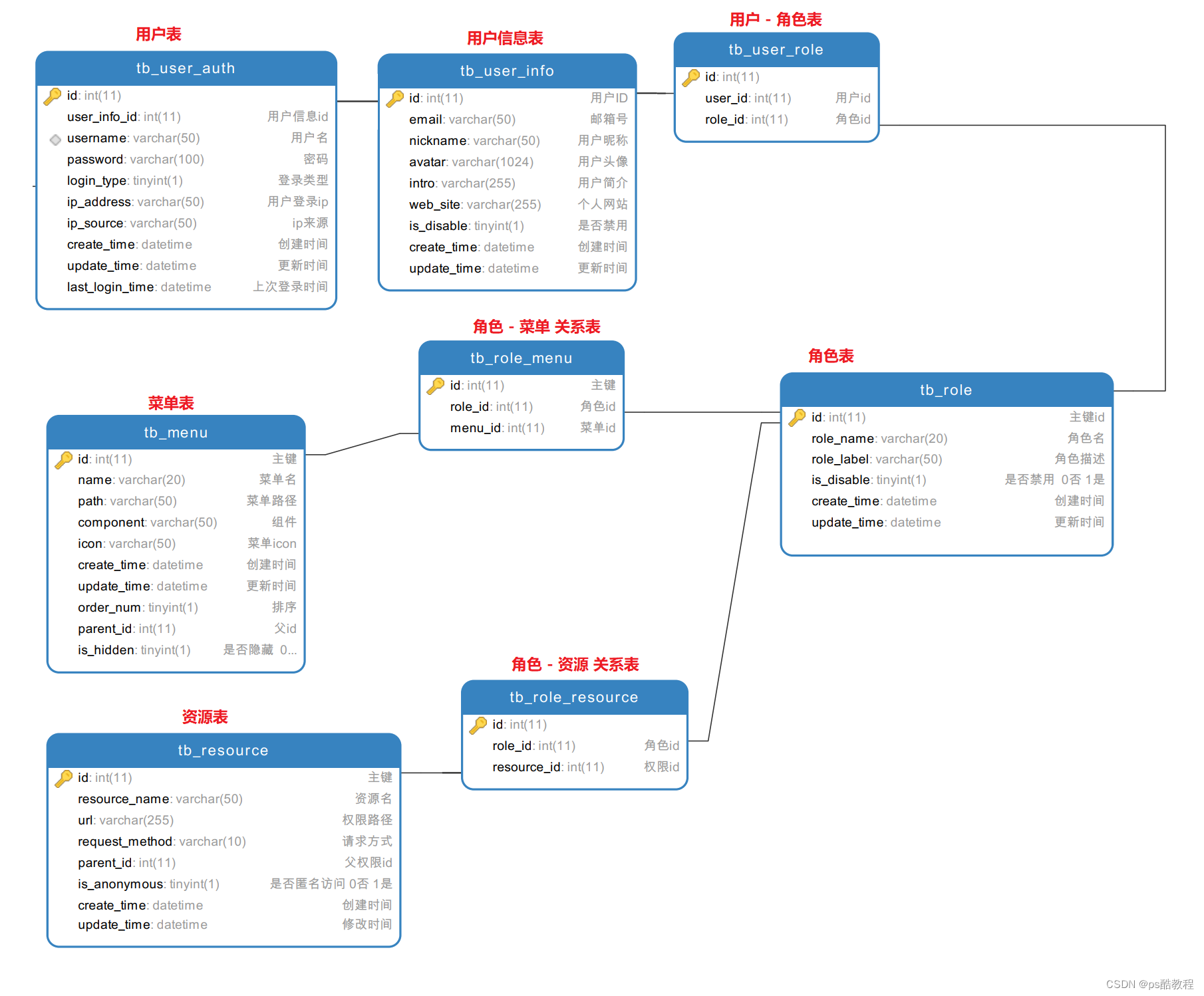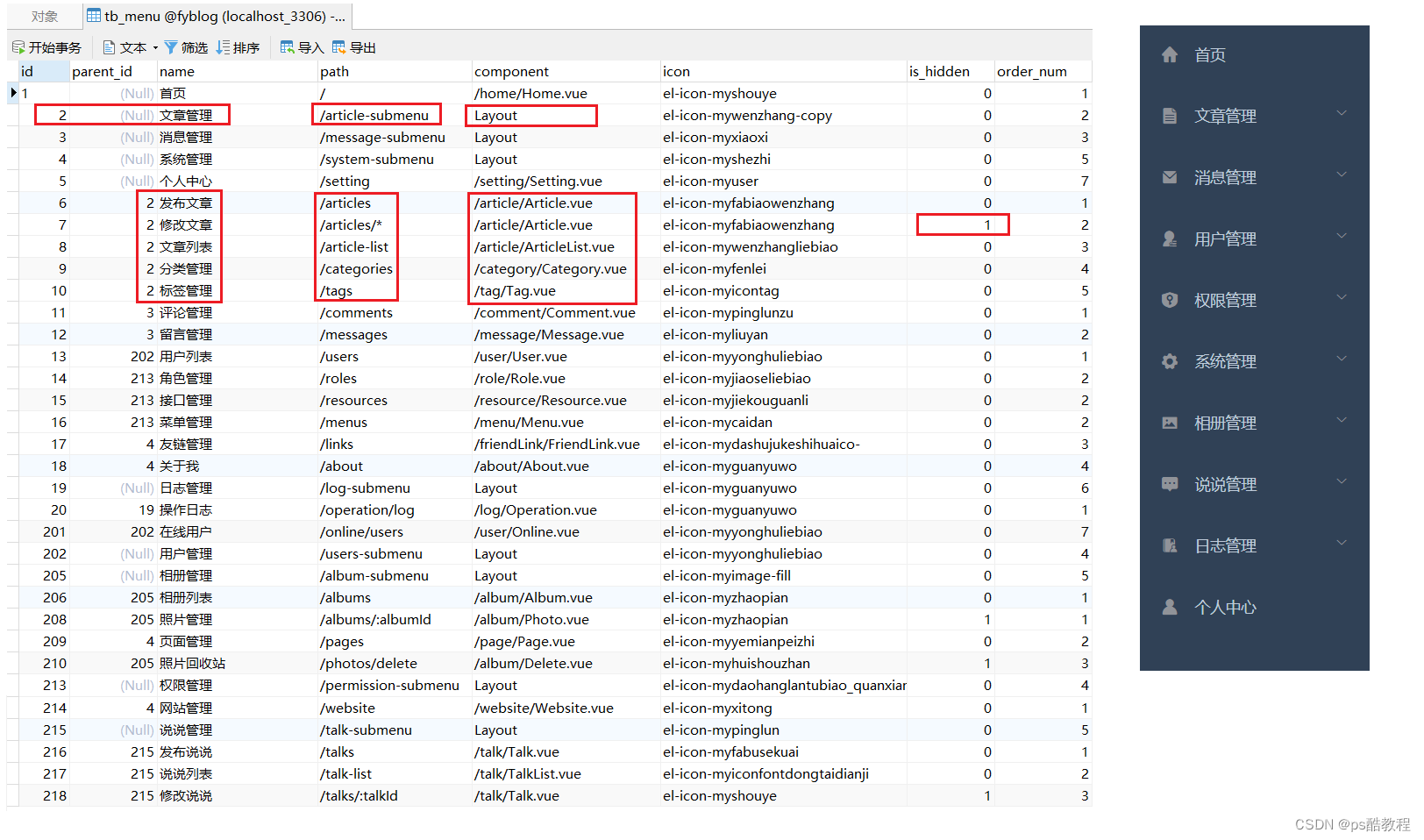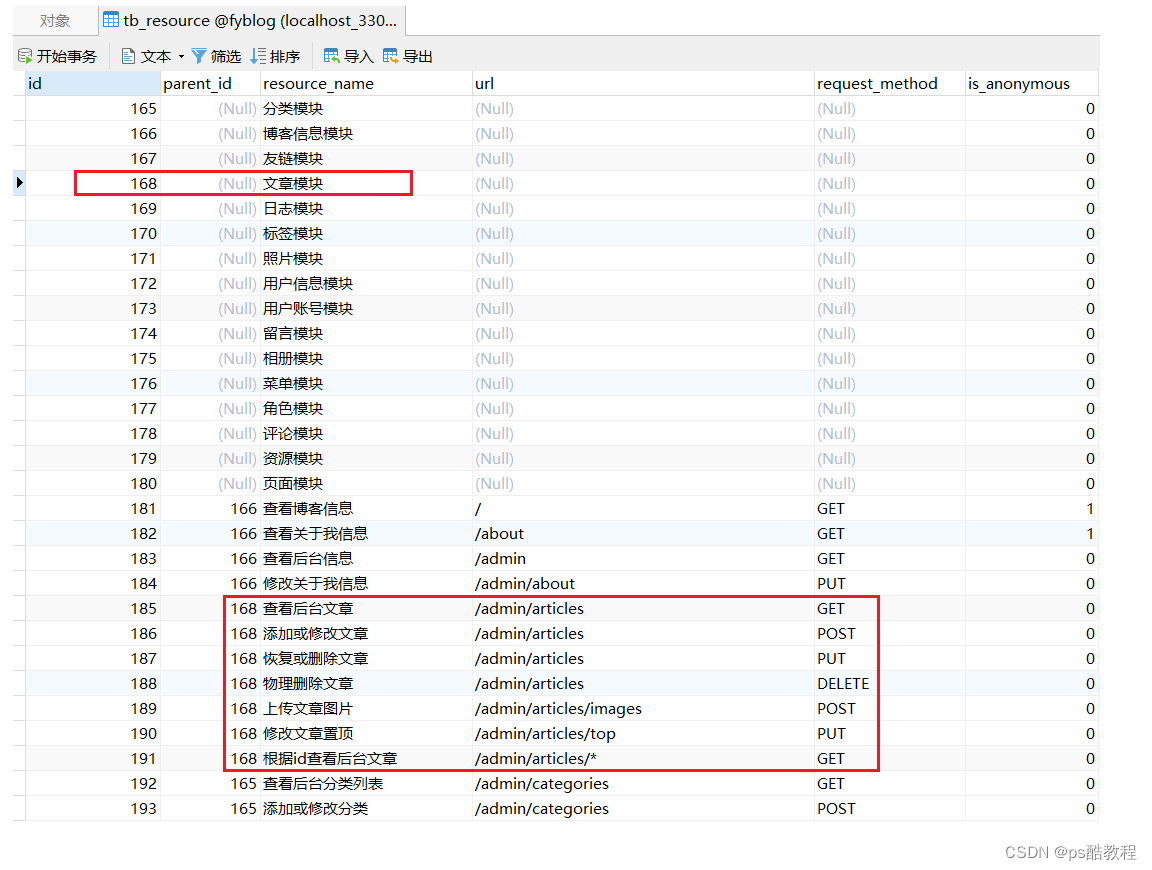学习风`宇博客用户权限菜单模块

文章目录
用户-角色-菜单-资源 各表关系图

菜单 和 路由
菜单表及分析

分析
要形成右边这种菜单,需要2部分来做支撑。
- 第一部分:需要构建出菜单之间的父子级关系出来。
- 在上表中,通过id与parent_id,就可以构建出来,但是应当注意到:它这种似乎没有做超过2级的菜单。它的这种,第一级要么是菜单,要么是目录,第二级只能是菜单,不能是目录。也就是说,目录下面不能是目录,只能是菜单(目前的前端vue项目里面没有对菜单做递归)。
- 第二部分:需要嵌套路由支持。
- 也就是要做到后台管理系统的这种布局,在切换菜单的时候,右侧主区域切换到不同的组件需要嵌套路由作支撑。
- 在考虑动态路由的时候,就不要考虑父子级之间的关系,只需要知道:要展示到主区域的组件在vue项目里面的路径(vue组件所在项目路径-表中的component字段),以及该路由组件的路径(vue组件对应的路由路径-表中的path字段)
/api/admin/user/menus接口
MenuServiceImpl#listUserMenus
@Override
public List<UserMenuDTO> listUserMenus() {// 查询用户菜单信息//(仅通过tb_user_role、tb_role_menu、tb_menu连表查询 用户拥有的角色 有哪些菜单)List<Menu> menuList = menuDao.listMenusByUserInfoId(UserUtils.getLoginUser().getUserInfoId());// 获取目录列表//(仅返回上一步查询到的菜单中parent_id为null的菜单)List<Menu> catalogList = listCatalog(menuList);// 获取目录下的子菜单//(将相同parent_id的菜单进行分组,以parent_id作为key,放入map中,// 从这里就看出来了,它不支持多级菜单了)Map<Integer, List<Menu>> childrenMap = getMenuMap(menuList);// 转换前端菜单格式return convertUserMenuList(catalogList, childrenMap);
}private List<UserMenuDTO> convertUserMenuList(List<Menu> catalogList, Map<Integer, List<Menu>> childrenMap) {// 遍历每个parent_id为null的菜单,// - 如果通过上面构建的map中,能找到它的子菜单,// 那么就把它当作多级菜单处理(认为是目录),// 将它的子菜单排序,并添加到children属性中;// - 如果没有找到,就作为菜单处理(认为是菜单),创建一个UserMenuDTO,并设置component为Layout,path为菜单的path// 将此菜单(path会被置为空字符串,这个设置空字符串是有意义的),添加到刚刚创建的UserMenuDTO的children中,// 也就是说,如果一级是菜单,会把它包到里面去;// 整个过程,没有使用递归 或者 通过构建map的方式 构建多级菜单,但是如果是一级菜单,它是会把它包一层的return catalogList.stream().map(item -> {// 获取目录UserMenuDTO userMenuDTO = new UserMenuDTO();List<UserMenuDTO> list = new ArrayList<>();// 获取目录下的子菜单List<Menu> children = childrenMap.get(item.getId());if (CollectionUtils.isNotEmpty(children)) {// 多级菜单处理userMenuDTO = BeanCopyUtils.copyObject(item, UserMenuDTO.class);list = children.stream().sorted(Comparator.comparing(Menu::getOrderNum)).map(menu -> {UserMenuDTO dto = BeanCopyUtils.copyObject(menu, UserMenuDTO.class);dto.setHidden(menu.getIsHidden().equals(TRUE));return dto;}).collect(Collectors.toList());} else {// 一级菜单处理userMenuDTO.setPath(item.getPath());userMenuDTO.setComponent(COMPONENT); // "Layouot"list.add(UserMenuDTO.builder().path("").name(item.getName()).icon(item.getIcon()).component(item.getComponent()).build());}userMenuDTO.setHidden(item.getIsHidden().equals(TRUE));userMenuDTO.setChildren(list);return userMenuDTO;}).collect(Collectors.toList());
}
接口返回示例及分析
- 观察下面的 首页 和 个人中心 的确是被包了一层,
- 刚刚提到 前端需要 侧边栏菜单 和 添加动态路由,那么这里只提供一个接口的话,并且里面没有分
菜单和路由,那么前端势必就要自己组装 出合适的数据格式了。- 大致猜想下,这2部分内容该如何组装出来?
- 路由:首先分析路由,这个比较简单,从下面的数据返回就可以看出来,它实际上已经大致和vue-router所需要的路由类似了,只需要把component的部分,通过
异步组件加载方式,把它导入进去就可以了。比如:下面的首页,当匹配到/,就会默认展示Layout,然后由于里面有一个path为空字符串的子路由,vue-router会把这个子路由渲染到Layout的路由出口的地方。里面还有个小问题,比如说下面的文章管理,它的path是/article-submenu,那我直接在地址上输入这个路径的话,它是会渲染一个Layout组件,然后路由出口是空的,也就是主区域是空白的,此时也可以给文章管理加一个path为空字符串的子路由,让它显示一个默认的页面,当然这个目录是点击不了的,只是为了防止用户输入这个路劲而已。此处可以参考:vue3后台管理系统、vue2异步组件 - 菜单: 侧边栏第一层级的菜单有可能是菜单,也有可能是目录,目录是不能点击的,只能作展开/收缩。那如何区分它们呢?因为使用element-ui组件去渲染左侧菜单,那么就必须知道,当前这个菜单有没有子菜单,如果有子菜单,用的是el-sub-menu,如果直接是一个菜单的话,那就是el-menu-item(此处可参考:vue3后台管理系统 的 使用el-menu创建侧边栏菜单 部分),可以通过name来进行判断,因为通过包了一层的方式生成的最外面的那层菜单的name是没有赋值的,因此,它肯定为null,也就是说,碰到为null的name的一级菜单,直接拿这个菜单下面的一个子菜单(这种只会存在一个子菜单),比如首页、个人中心就是这样的。还有的就是有name的菜单就通过el-sub-menu把它渲染出来,这样,他就是一个目录了。
- 路由:首先分析路由,这个比较简单,从下面的数据返回就可以看出来,它实际上已经大致和vue-router所需要的路由类似了,只需要把component的部分,通过
- 大致猜想下,这2部分内容该如何组装出来?
{"flag":true,"code":20000,"message":"操作成功","data":[{"name":null,"path":"/","component":"Layout","icon":null,"hidden":false,"children":[{"name":"首页","path":"","component":"/home/Home.vue","icon":"el-icon-myshouye","hidden":null,"children":null}]},{"name":"文章管理","path":"/article-submenu","component":"Layout","icon":"el-icon-mywenzhang-copy","hidden":false,"children":[{"name":"发布文章","path":"/articles","component":"/article/Article.vue","icon":"el-icon-myfabiaowenzhang","hidden":false,"children":null},{"name":"修改文章","path":"/articles/*","component":"/article/Article.vue","icon":"el-icon-myfabiaowenzhang","hidden":true,"children":null},{"name":"文章列表","path":"/article-list","component":"/article/ArticleList.vue","icon":"el-icon-mywenzhangliebiao","hidden":false,"children":null},{"name":"分类管理","path":"/categories","component":"/category/Category.vue","icon":"el-icon-myfenlei","hidden":false,"children":null},{"name":"标签管理","path":"/tags","component":"/tag/Tag.vue","icon":"el-icon-myicontag","hidden":false,"children":null}]},{"name":"消息管理","path":"/message-submenu","component":"Layout","icon":"el-icon-myxiaoxi","hidden":false,"children":[{"name":"评论管理","path":"/comments","component":"/comment/Comment.vue","icon":"el-icon-mypinglunzu","hidden":false,"children":null},{"name":"留言管理","path":"/messages","component":"/message/Message.vue","icon":"el-icon-myliuyan","hidden":false,"children":null}]},{"name":"用户管理","path":"/users-submenu","component":"Layout","icon":"el-icon-myyonghuliebiao","hidden":false,"children":[{"name":"用户列表","path":"/users","component":"/user/User.vue","icon":"el-icon-myyonghuliebiao","hidden":false,"children":null},{"name":"在线用户","path":"/online/users","component":"/user/Online.vue","icon":"el-icon-myyonghuliebiao","hidden":false,"children":null}]},{"name":"权限管理","path":"/permission-submenu","component":"Layout","icon":"el-icon-mydaohanglantubiao_quanxianguanli","hidden":false,"children":[{"name":"角色管理","path":"/roles","component":"/role/Role.vue","icon":"el-icon-myjiaoseliebiao","hidden":false,"children":null},{"name":"接口管理","path":"/resources","component":"/resource/Resource.vue","icon":"el-icon-myjiekouguanli","hidden":false,"children":null},{"name":"菜单管理","path":"/menus","component":"/menu/Menu.vue","icon":"el-icon-mycaidan","hidden":false,"children":null}]},{"name":"系统管理","path":"/system-submenu","component":"Layout","icon":"el-icon-myshezhi","hidden":false,"children":[{"name":"网站管理","path":"/website","component":"/website/Website.vue","icon":"el-icon-myxitong","hidden":false,"children":null},{"name":"页面管理","path":"/pages","component":"/page/Page.vue","icon":"el-icon-myyemianpeizhi","hidden":false,"children":null},{"name":"友链管理","path":"/links","component":"/friendLink/FriendLink.vue","icon":"el-icon-mydashujukeshihuaico-","hidden":false,"children":null},{"name":"关于我","path":"/about","component":"/about/About.vue","icon":"el-icon-myguanyuwo","hidden":false,"children":null}]},{"name":"相册管理","path":"/album-submenu","component":"Layout","icon":"el-icon-myimage-fill","hidden":false,"children":[{"name":"相册列表","path":"/albums","component":"/album/Album.vue","icon":"el-icon-myzhaopian","hidden":false,"children":null},{"name":"照片管理","path":"/albums/:albumId","component":"/album/Photo.vue","icon":"el-icon-myzhaopian","hidden":true,"children":null},{"name":"照片回收站","path":"/photos/delete","component":"/album/Delete.vue","icon":"el-icon-myhuishouzhan","hidden":true,"children":null}]},{"name":"说说管理","path":"/talk-submenu","component":"Layout","icon":"el-icon-mypinglun","hidden":false,"children":[{"name":"发布说说","path":"/talks","component":"/talk/Talk.vue","icon":"el-icon-myfabusekuai","hidden":false,"children":null},{"name":"说说列表","path":"/talk-list","component":"/talk/TalkList.vue","icon":"el-icon-myiconfontdongtaidianji","hidden":false,"children":null},{"name":"修改说说","path":"/talks/:talkId","component":"/talk/Talk.vue","icon":"el-icon-myshouye","hidden":true,"children":null}]},{"name":"日志管理","path":"/log-submenu","component":"Layout","icon":"el-icon-myguanyuwo","hidden":false,"children":[{"name":"操作日志","path":"/operation/log","component":"/log/Operation.vue","icon":"el-icon-myguanyuwo","hidden":false,"children":null}]},{"name":null,"path":"/setting","component":"Layout","icon":null,"hidden":false,"children":[{"name":"个人中心","path":"","component":"/setting/Setting.vue","icon":"el-icon-myuser","hidden":null,"children":null}]}]
}
前端代码分析
menu.js
- 下面的代码只遍历了2层,只处理了图标 和 路由的组件异步加载,和 Layout的字符串转为实际的Layout组件,这些都是vue-router的要求。
- 路由 和 菜单 用的 是同一份数据。此处可与vue3后台管理系统 # 调整路由处作对比学习,感觉的确他的更加灵活一点,他的可以不同path的路径都可以用Layout作为App.vue的路由出口展示的组件。我的是直接就当作Layout的子路由了,但更加简单,但有一点必须作为前提,那就是一点要跟着vue-router的用法走,这个是大前提,所以做的时候,肯定需要先把静态路由搭建出来,确认没问题之后,再搞动态路由。
import Layout from "@/layout/index.vue";
import router from "../../router";
import store from "../../store";
import axios from "axios";
import Vue from "vue";export function generaMenu() {// 查询用户菜单axios.get("/api/admin/user/menus").then(({ data }) => {if (data.flag) {var userMenuList = data.data;userMenuList.forEach(item => {if (item.icon != null) {item.icon = "iconfont " + item.icon;}if (item.component == "Layout") {item.component = Layout;}if (item.children && item.children.length > 0) {item.children.forEach(route => {route.icon = "iconfont " + route.icon;route.component = loadView(route.component);});}});// 添加侧边栏菜单store.commit("saveUserMenuList", userMenuList);// 添加菜单到路由router.addRoutes(userMenuList);} else {Vue.prototype.$message.error(data.message);router.push({ path: "/login" });}});
}export const loadView = view => {// 路由懒加载return resolve => require([`@/views${view}`], resolve);
};
SideBar.vue
- 此处可对照 vue3后台管理系统 # 使用el-menu创建侧边栏菜单
- 下面只做了2级遍历。多级菜单实现可参考: vue3后台管理系统 # 创建TreeMenu.vue递归组件
<template><div><el-menuclass="side-nav-bar"router:collapse="this.$store.state.collapse":default-active="this.$route.path"background-color="#304156"text-color="#BFCBD9"active-text-color="#409EFF"><template v-for="route of this.$store.state.userMenuList"><!-- 二级菜单 --><template v-if="route.name && route.children && !route.hidden"><el-submenu :key="route.path" :index="route.path"><!-- 二级菜单标题 --><template slot="title"><i :class="route.icon" /><span>{{ route.name }}</span></template><!-- 二级菜单选项 --><template v-for="(item, index) of route.children"><el-menu-item v-if="!item.hidden" :key="index" :index="item.path"><i :class="item.icon" /><span slot="title">{{ item.name }}</span></el-menu-item></template></el-submenu></template><!-- 一级菜单 --><template v-else-if="!route.hidden"><el-menu-item :index="route.path" :key="route.path"><i :class="route.children[0].icon" /><span slot="title">{{ route.children[0].name }}</span></el-menu-item></template></template></el-menu></div>
</template>
接口权限控制
资源表 及 分析

分析
- 将系统中的每一controller里面的接口,当作一个资源,接口名称就是资源名称、接口访问路径就是资源url。每一个controller类也是一个资源,它用来管理内部的接口(作为它们的父资源,父资源的parent_id为null),也就是说里面只会存在2级关系。
- 使用角色 去 关联 资源,用户 去 关联 角色,因此,就可以确定一个用户拥有哪些资源。一个角色如果关联了某个controller下面的某个或者某几个资源,那么它一定关联了这个controller资源(也就是子关联了,那么父也一定要关联)。那个菜单也应如此,但是我发现,角色分配菜单那里,选择了子菜单,却没有自动勾选对应的父级菜单,连父级菜单都没的话,返回的就是空菜单。资源那里是正常的。
- 当确定某个用户具有哪些角色,就可以确定这个用户拥有了哪些资源,其实,就是拥有了哪些接口的访问权限,接口的访问权限是通过security这个权限框架控制的,并且博客中是做到了动态权限控制,即。
WebSecurityConfig
package com.minzheng.blog.config;import com.minzheng.blog.handler.*;
import org.springframework.beans.factory.annotation.Autowired;
import org.springframework.context.annotation.Bean;
import org.springframework.context.annotation.Configuration;
import org.springframework.security.access.AccessDecisionManager;
import org.springframework.security.config.annotation.ObjectPostProcessor;
import org.springframework.security.config.annotation.web.builders.HttpSecurity;import org.springframework.security.config.annotation.web.configuration.EnableWebSecurity;
import org.springframework.security.config.annotation.web.configuration.WebSecurityConfigurerAdapter;
import org.springframework.security.core.session.SessionRegistry;
import org.springframework.security.core.session.SessionRegistryImpl;
import org.springframework.security.crypto.bcrypt.BCryptPasswordEncoder;
import org.springframework.security.crypto.password.PasswordEncoder;
import org.springframework.security.web.access.intercept.FilterInvocationSecurityMetadataSource;
import org.springframework.security.web.access.intercept.FilterSecurityInterceptor;
import org.springframework.security.web.session.HttpSessionEventPublisher;/* Security配置类 @author yezhiqiu* @date 2021/07/29*/
@Configuration
@EnableWebSecurity
public class WebSecurityConfig extends WebSecurityConfigurerAdapter {@Autowiredprivate AuthenticationEntryPointImpl authenticationEntryPoint;@Autowiredprivate AccessDeniedHandlerImpl accessDeniedHandler;@Autowiredprivate AuthenticationSuccessHandlerImpl authenticationSuccessHandler;@Autowiredprivate AuthenticationFailHandlerImpl authenticationFailHandler;@Autowiredprivate LogoutSuccessHandlerImpl logoutSuccessHandler;@Beanpublic FilterInvocationSecurityMetadataSource securityMetadataSource() {return new FilterInvocationSecurityMetadataSourceImpl();}@Beanpublic AccessDecisionManager accessDecisionManager() {return new AccessDecisionManagerImpl();}@Beanpublic SessionRegistry sessionRegistry() {return new SessionRegistryImpl();}@Beanpublic HttpSessionEventPublisher httpSessionEventPublisher() {return new HttpSessionEventPublisher();}/* 密码加密 @return {@link PasswordEncoder} 加密方式*/@Beanpublic PasswordEncoder passwordEncoder() {return new BCryptPasswordEncoder();}/* 配置权限 @param http http* @throws Exception 异常*/@Overrideprotected void configure(HttpSecurity http) throws Exception {// 配置登录注销路径http.formLogin().loginProcessingUrl("/login").successHandler(authenticationSuccessHandler).failureHandler(authenticationFailHandler).and().logout().logoutUrl("/logout").logoutSuccessHandler(logoutSuccessHandler);// 配置路由权限信息http.authorizeRequests().withObjectPostProcessor(new ObjectPostProcessor<FilterSecurityInterceptor>() {@Overridepublic <O extends FilterSecurityInterceptor> O postProcess(O fsi) {fsi.setSecurityMetadataSource(securityMetadataSource());fsi.setAccessDecisionManager(accessDecisionManager());return fsi;}}).anyRequest().permitAll().and()// 关闭跨站请求防护.csrf().disable().exceptionHandling()// 未登录处理.authenticationEntryPoint(authenticationEntryPoint)// 权限不足处理.accessDeniedHandler(accessDeniedHandler).and().sessionManagement().maximumSessions(20).sessionRegistry(sessionRegistry());}}

